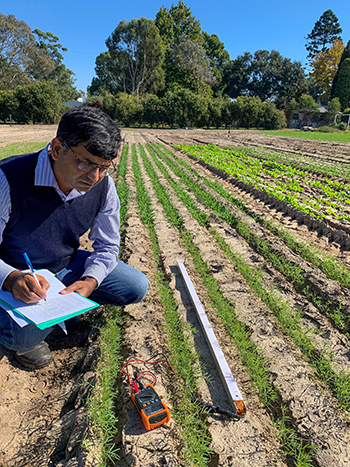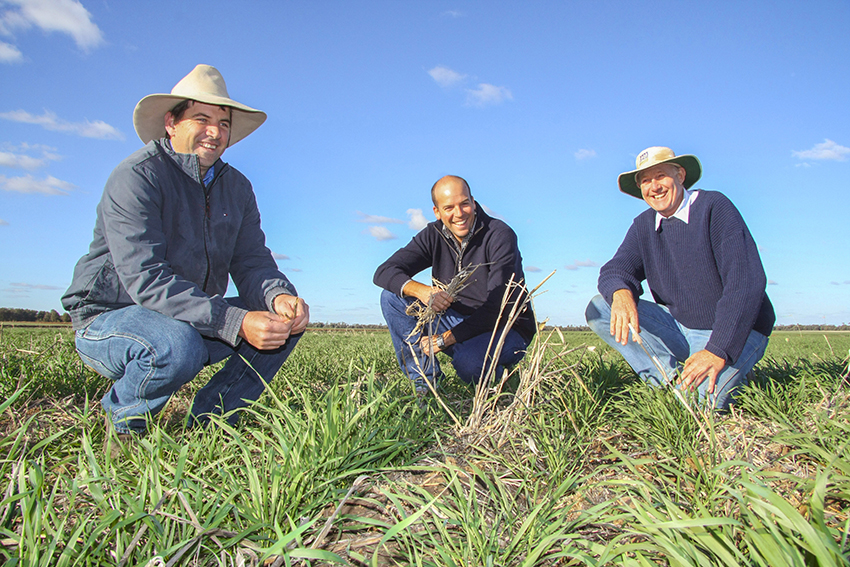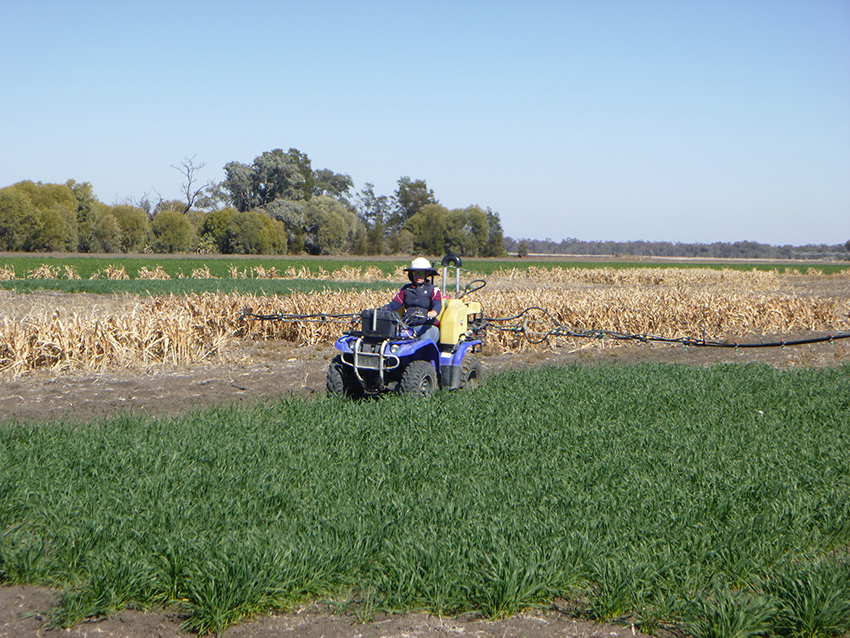Key points
- Before planting a cover crop, know what you want to achieve (such as weed suppression or increased water infiltration)
- Grass cover crops perform well in improving fallow water capture and suppressing weeds
- Legume cover crops compete poorly under high weed pressure
Research has identified the best cover crops to suppress weeds in New South Wales and Queensland.
Cover crops are mostly planted during summer or winter as an alternative to leaving paddocks bare.
University of Sydney Associate Professor Michael Walsh says growers generally sow cover crops to improve rainfall infiltration and soil health.
“By soil health, I mean they can fix carbon, improve soil porosity and increase nutrient cycling,” he says.
“However, a key focus of our research was to explore the impact of different cover crop species and dual-species mixtures on weed growth and development.”
Multi-site trials
With GRDC investment, researchers assessed summer and winter cover crops at Wagga Wagga and Narrabri, New South Wales and Kingaroy in Queensland.
Scientists from Charles Sturt University (CSU), the University of Sydney and the Queensland Department of Agriculture and Fisheries (DAF), led by CSU Research Professor Leslie Weston, assessed winter and summer cover crops to determine:
- the effects of monoculture cover crops on early season weed suppression;
- the effects of dual-species mixtures on biomass and weed suppression; and
- the ability of monocultures and mixtures to affect plant-available soil moisture.
Harvesting rain
Dr Walsh says summer cover crops represent a significant opportunity.
“Most of Queensland and northern NSW typically receives a significant amount of summer rainfall. There is an opportunity to use cover crops to harvest the water that frequently runs off bare paddocks, especially those on black cracking clay soils,” he says.
“But soil surface coverage with quick-growing, high-biomass crops prevents lateral water movement across paddocks and improves water infiltration.”
The researchers wanted to explore crops that demonstrated high early vigour and large biomass production to maximise water infiltration and minimise moisture export.
Summer covers
University of Sydney weeds ecologist Dr Asad Shabbir spearheaded the summer cover crops research at Narrabri. During November, he and his team planted sorghum, sudangrass hybrid, cowpea, lablab, white French millet, Japanese millet, teff and buckwheat.

Dr Asad Shabbir from the University of Sydney taking light interception measurements in experiments. Photo: Nouman Sohail
Cover crop mixtures tested at Narrabri included teff-cowpea and millet-lablab.
The summer blends assessed at Wagga Wagga included millet-cowpea and millet-lablab.
Crop species in each mixture were assessed at different ratios: 0:100, 75:25, 50:50, 25:75 and 100:0.
Researchers terminated some crops at the early vegetative stage (about 40 days after sowing) and some during flowering (about 80 days after sowing).
They measured crop and weed biomass at early and late growth stages. Using capacitance probes, soil water was measured at 20 centimetres and 70cm.
At Narrabri, all cover crops suppressed weed growth.
Dr Shabbir says forage sorghum and the sudangrass hybrid produced the most biomass by day 40 and 80, with no weeds found.
At Wagga Wagga, forage sorghum produced the most biomass regardless of termination time.
Dr Shabbir says that although forage sorghum produced the most biomass, buckwheat was more suppressive of weed growth at both termination times.
Forage sorghum performed well in cover crop trials at Narrabri, New South Wales. Photo: Asad Shabbir
“It appears buckwheat releases allelochemicals that inhibit weed emergence and growth,” he says.
Species mixtures
At Narrabri, researchers compared millet-lablab mixtures at different ratios.
Dr Shabbir says the millet was the main contributor to biomass in the millet-lablab mixture.
“By day 40, millet-lablab biomass production was lower than the millet monoculture,” he says.
“But by day 80, the biomass of the mixture was higher than millet alone.
“The takeaway from this is that grass is important in a cover crop mixture, but legumes add nitrogen and diversity, which is likely to be better for soil biota and fertility.”
Dr Shabbir says a teff-cowpea mixture was also tested: “Teff is a comparatively new grass species for forage in grain production regions. It performed well, although was not as vigorous as millet during early growth.
“From day 40 to 80, teff growth was more vigorous, and the 50:50 teff-cowpea mixture produced more than 10 tonnes per hectare of biomass.”
Dr Shabbir suspects the cowpea added nitrogen, which supercharged the growth of the cover crop mixture.
At Wagga Wagga, where weed pressure was high, researchers assessed a millet-cowpea mixture. The results showed millet alone performed well in suppressing weed growth, but the 75:25 mixture of millet-cowpea produced even more biomass than the grass alone by day 100.
A buckwheat cover crop at Narrabri, New South Wales. Photo: Asad Shabbir
A millet-lablab mixture was also tested at Wagga Wagga, with millet contributing significantly to the biomass.
By day 100, the 50:50 millet-cowpea mixture produced the most biomass; however, it was not as weed suppressive as the pure millet cover crop.
Soil water
A secondary aim was to explore the impact of cover crops and termination timings on soil moisture.
Dr Shabbir says the results showed cover crop species and termination time had no effect on soil water availability.
He says this is probably because more than 250 millimetres of rain fell during the trials at Narrabri and Wagga Wagga.
Summer cover crop experiments were planted in November 2021 at both locations to assess the impact on soil water at crop termination in early 2022.
Winter covers
Researchers assessed winter cover crops at Kingaroy, Queensland, Narrabri and Wagga Wagga.
Charles Sturt University research fellow Dr Saliya Gurusinghe spearheaded the experiments.
Initially, he and his team assessed 15 cover crop species for weed suppression. Later, they narrowed the monoculture species to six. The monoculture cover crops included white lupins, arrowleaf clover, field peas, forage oats, tillage radish and vetch.
Also evaluated were three dual cover crop mixtures. These included vetch-forage oats, field peas-forage oats and field peas-tillage radish.
Each species within each cover crop mixture was tested at different ratios to determine the optimum percentage of legume to tillage radish or grass species.
The crops were planted in mid-May at Wagga Wagga and in late April at Narrabri.
At Narrabri and Wagga Wagga, the researchers relied on the natural weed seedbank, which was high.
Dr Gurusinghe says the legume species produced poor early ground cover, but the forage oats and tillage radish covered the soil quickly.
“If you want to suppress early winter weeds, forage oats and tillage radish do that well.”
However, he says growing forage oats as a monoculture cover crop is not ideal because it could lead to disease management issues in continuous cereal phases.
“Tillage radish helps to break the disease cycle while also improving soil porosity because of its large taproot,” he says.
Biomass production
The results demonstrated that tillage radish and forage oats produced high biomass levels by day 60. But, by day 90, the forage oats biomass was significantly higher than all other cover crop species. By day 110, the forage oat treatment still had the highest biomass production. However, the tillage radish treatments had almost caught up.
In terms of weed biomass under the different monocultures at Wagga Wagga, Dr Gurusinghe made several observations:
- at the start of the experiment, the treatments were weed free, and researchers did not apply herbicide;
- by day 90, weed biomass under the white lupins was about 3t/ha because white lupins demonstrated low early vigour;
- arrowleaf clover had more than 4t/ha of weed biomass by day 90;
- vetch grew more vigorously than field peas but did not entirely suppress weeds;
- by day 90, the field pea treatments had allowed the growth of more than 1.0t/ha of weed biomass; and
- tillage radish and forage oats reduced weed biomass by as much as 99 per cent when compared to a fallow control.
Dual mixtures
Dr Gurusinghe says two cover crop species were also sown together at different rates to assess the impact on weeds.
In the forage oat-vetch mixture, changing the percentage of forage oats to vetch had no significant impact on weed biomass.
However, in the forage oat-field pea mixture, he says, forage oats needed to comprise at least 25 per cent of the mix to suppress weeds.
The tillage radish-field pea mix performed better than other mixtures. Specifically, the 25 per cent tillage radish to 75 per cent field pea mixture was enough to suppress weeds.
At Kingaroy, forage oats, tillage radish and vetch produced the most biomass and performed well in suppressing weeds.
“Vetch was a better choice in comparison to field peas at Kingaroy,” he says.
When the dual mixtures were assessed, Dr Gurusinghe says any combination of species performed as well as a pure stand of forage oats.
At Narrabri, the field peas, forage oats, vetch and tillage radish performed similarly in suppressing weed growth.
Soil water
Dr Gurusinghe says terminating cover crops at early vegetative growth rather than at flowering leaves more moisture for the following crop.
“Soil water use will be similar between the monocultures and the dual mixtures,” he says.
In related research, DAF research agronomist Andrew Erbacher says high levels of ground cover improve fallow efficiency, allowing captured rainfall to be used by the next crop.
“In Queensland and the northern half of NSW, the amount of stored soil water in the soil profile at planting will improve the reliability of crop yield,” he says.
“In wet growing seasons, the amount of stored soil moisture is less important but in an average or drier season, if you don’t have water in the ‘bucket’ you’re setting yourself up for failure.”
In DAF, CSIRO and NSW Department of Primary Industries farming systems trials, with GRDC co-investment, Mr Erbacher and his team compared the fallow efficiency of wheat (which provides ample ground cover) with chickpeas (which leave low residue levels on the soil surface).
Results showed the fallow efficiency of a crop planted after wheat is, on average, about double that of chickpeas.
“If you have a fallow with nil or low levels of ground cover, there will be some water ‘in the bucket’ but it will take longer to accumulate enough to grow a profitable grain crop,” Mr Erbacher says.
“After you terminate the cover crop, you’ll improve fallow efficiency and, if your fallow length and/or rainfall is high enough, you’ll have more water than if you left the paddock bare.”
CSIRO’s Brook Anderson modelled the impacts of a spring-planted cover crop in a short fallow between sorghum and wheat.
“Her results showed a soil water storage benefit from cover crops in 50 to 70 per cent of years, with an average increase of 17mm across all years, equating to about 250 kilograms/ha/year of extra grain yield potential.
“Added to this, cover crops can reduce the need to apply a fallow spray in paddocks, reducing input costs and potentially delaying the onset of herbicide resistance in weeds.”
Crop residues
For researchers, determining which mechanisms are involved in cover crop weed suppression in field trials is challenging.
Dr Gurusinghe says researchers believe allelochemicals released from crop residues also have a role in inhibiting weed seed germination.
Accordingly, he set up a laboratory experiment with annual ryegrass and cress to determine whether crop residues are active against weed seed germination.
“All cover crop stubbles (that) we assessed, but particularly forage oats and tillage radish residues, had a strong impact on weed seed germination,” he says.
“The results showed that higher residue loads were associated with lower weed seed germination.”
Cover crop agronomy considerations

From left, DAF research agronomist Andrew Erbacher, grower Dave Woods, and MCA Goondiwindi agronomist Stuart Thorn in a trial where Sunmax (PBR) wheat has been planted into a defoliated cover crop of white French millet. Photo: Liz Wells
Queensland Department of Agriculture and Fisheries (DAF) research agronomist Andrew Erbacher says his objective in growing a cover crop is to select a species that will reach peak biomass production as quickly as possible so it can be terminated early.
“Millet followed by sorghum are the two cover crop species most commonly grown in Queensland,” he says.
“Millet is small-seeded and germinates at cool temperatures, which allows earlier sowing in spring.
“The aim is to have the crop sprayed out as early as possible to improve the chance of soil water recharge ahead of sowing.”
He says sorghum has a much-larger seed, so can be planted deeper than millet, which leads to even establishment in hotter or drying soils.
Mr Erbacher says using weeds as a cover crop does not improve fallow efficiency.
“NSW Department of Primary Industries research agronomist Colin McMaster observed that allowing weeds to grow over summer as a type of ‘cover crop’ resulted in sporadic weed germination and uneven ground cover,” he says.
“The key to achieving a soil moisture benefit from a cover crop is having an effective and even establishment and terminating the crop as soon as the volume and type of stubble needed are produced.”
Starter nutrition
The need to apply starter fertiliser with the cover crop will depend on soil nutrient reserves.
“A soil test will indicate if there is enough available phosphorus and nitrogen for high early seedling vigour,” he says. “A crop with adequate nutrition will use water more efficiently to grow biomass.”
Seeding targets
Mr Erbacher says cover crops are ideally planted on narrow row spacings to provide even ground cover quickly.
“For millet, we targeted an establishment rate of one million plants per hectare,” he says. “For sorghum, the target was 300,000 to 400,000 plants/ha.”
Species selection
If only a short fallow period is available, Mr Erbacher says, a small and leafy species such as legumes or tillage radish might be suitable.
“For long fallows, keeping millet or sorghum growing until flowering will provide more robust soil protection.”
He suggests selecting a variety that will reach the desired growth stage quickly, enabling early termination.
“In Queensland and northern NSW, growing cover crops for too long can produce excessive biomass and rob water from the next crop, overshadowing any of the other benefits the cover crop could provide.”
Disease issues
In terms of disease, he says that following a cereal cover crop with a wheat cash crop could lead to crown rot in the wheat.
“Think about what cash crop will follow your cover crop, because this will allow you to select a cover that is less likely to increase the disease risk.”
Nitrogen
Cover crops will use nitrogen, he says, potentially tying up what nitrogen is available to the next cash crop, but because their residue is retained it will become available as the cover crop breaks down.
“Soil test to know what nutrients are available and you may need to apply extra nitrogen, phosphorus or sulfur – if these are limiting – for the following crop,” he says.
“If you grow a quick-growing cover crop that is terminated at the late vegetative growth stage, the residue is likely to break down quickly.
“Accordingly, the nitrogen contained in the residue will cycle more quickly than if the crop is terminated at flowering.”
Decision-making
When it comes to deciding whether to grow a cover crop, Mr Erbacher encourages the use of the CliMate or Soilwater app.
“I usually run the Soilwater app with zero ground cover and 50 millimetres of starting soil water,” he says. “I’ll then re-run the app with 100 per cent ground cover and zero starting soil water.”
“This allows you to consider the probable plant available water at your ideal planting date. We use 50mm of starting soil water based on observations we made in our trials, where our mid-terminated cover crop was, on average, 50mm drier than our control at spray-out.
“This exercise also provides some ‘rules-of-thumb’ about when the cover crops can be of most benefit.”
By way of example, he pointed to growers at Goondiwindi, Queensland, who plant cover crops after double skip-row sorghum in a long fallow going into wheat in the following year.
He says their aim is to sow millet in spring and terminate it by Christmas. “If the spring break doesn’t eventuate or the growers are not likely to have the crop sprayed out by Christmas, they don’t plant a cover crop.
“Think about your system, where you are located and when rain generally falls to develop some ‘rules-of-thumb’.”
He says the next step is considering when you will break your ‘rules-of-thumb’ based on seasonal forecasts.
When to terminate?

Spraying out a cover crop in Queensland Department of Agriculture and Fisheries trials. Photo: DAF
Suppose you want to use a cover crop to produce a significant amount of biomass to rid a paddock of weeds.
In that case, University of Sydney weeds ecologist Dr Asad Shabbir says terminating the cover crop later in its development will provide more-persistent weed control.
However, leaving enough soil moisture for the following crop is also critical, and the likelihood of recharging the soil profile with water after the crop is terminated, particularly in drier conditions, needs to be considered.
Charles Sturt University research fellow Dr Saliya Gurusinghe says plants reach peak biomass production by the late vegetative stage.
“Beyond this period, the plants enter the reproductive phase, which is likely to dry out the soil in low-rainfall seasons,” he says.
Queensland Department of Agriculture and Fisheries research agronomist Andrew Erbacher agrees, saying he had a plot in one of his experiments that was not terminated as planned.
“That plot demonstrated soil water significantly decreased in the two weeks after flowering for no extra biomass,” he says. “This was because the crop was using water to produce seed.”
More information: Michael Walsh, m.j.walsh@sydney.edu.au; Asad Shabbir, asad.shabbir@sydney.edu.au; Saliya Gurusinghe, sgurusinghe@csu.edu.au; Andrew Erbacher, andrew.erbacher@daf.qld.gov.au



























































